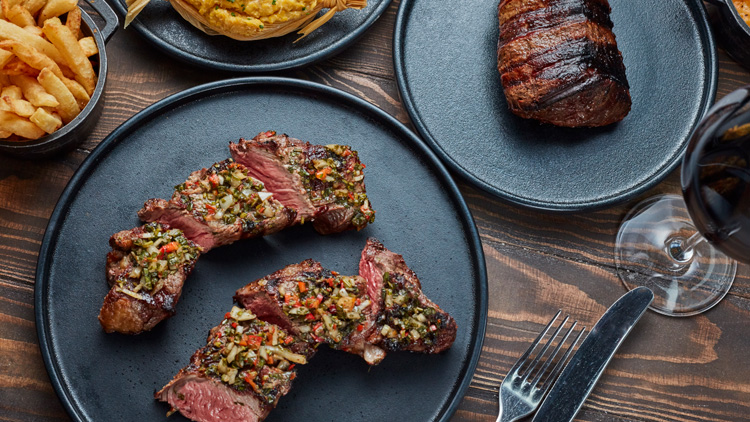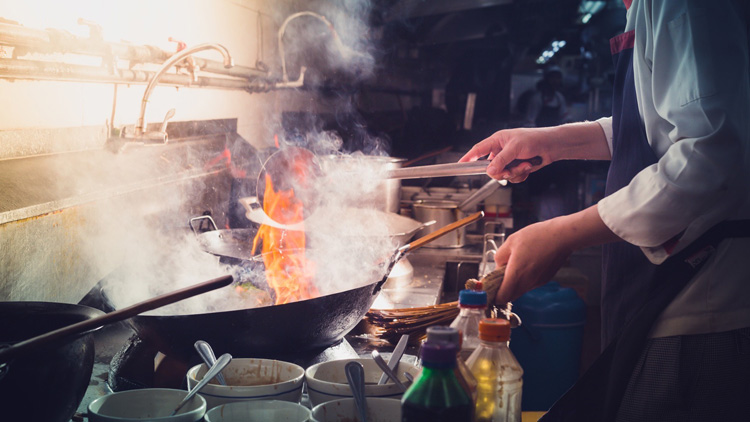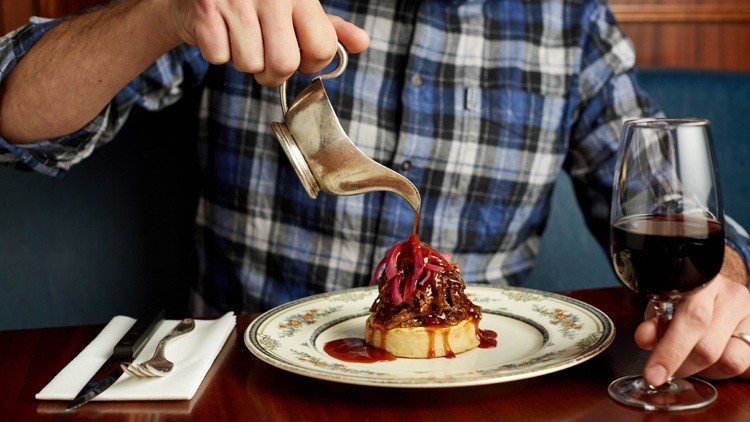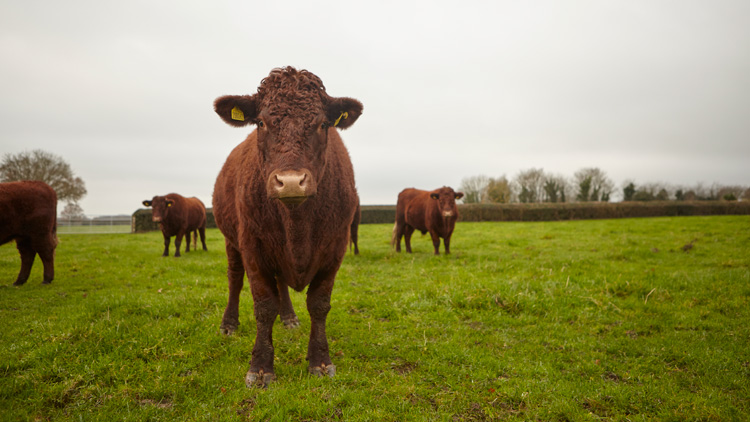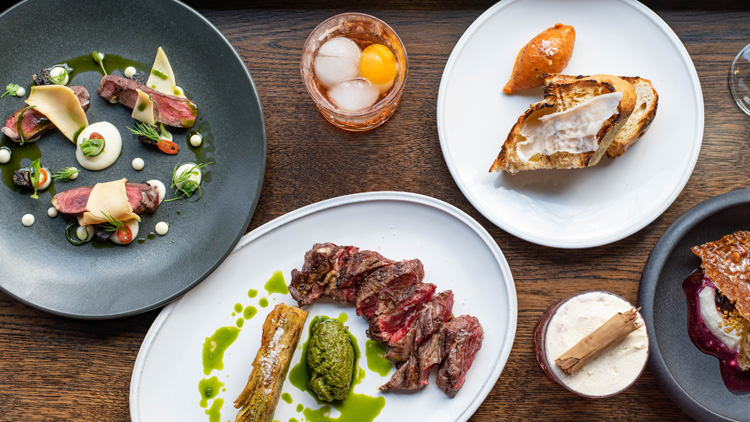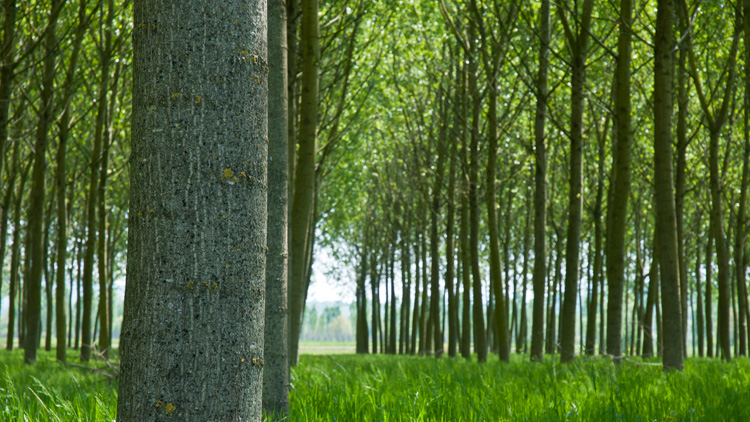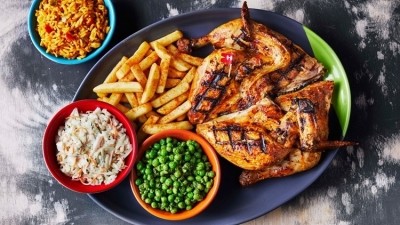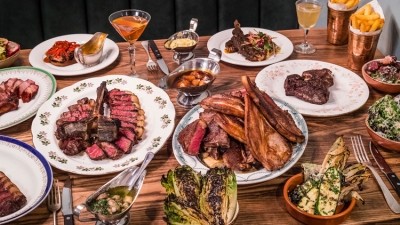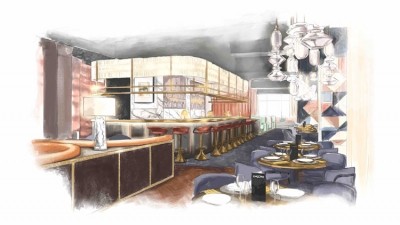Emission impossible? The meat-focused restaurants trying to reach net zero
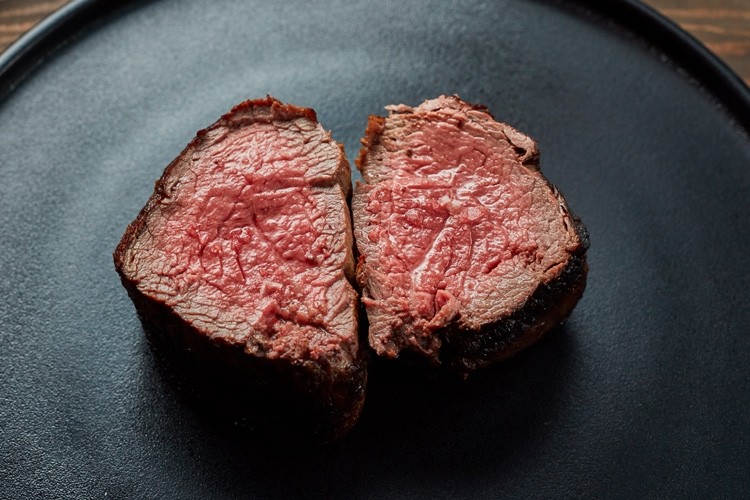
To the casual observer, the steaks being served at Gaucho’s newly refurbished flagship restaurant in London’s Fitzrovia are no different to those that were on the menu before. I order the 300g ribeye rare, and it arrives suitably bloody and full of flavour.
There is a crucial difference, though. While the beef itself, which comes from premium Black-Angus cattle that graze on the pampas plains of Argentina, hasn’t changed, its environmental impact has.
“All our beef is now carbon neutral,” states Martin Williams, proudly, as we chat over lunch in the Charlotte Street restaurant. ‘Sustainable steaks’ reads the menu, alongside an explanation that the restaurant’s beef is ‘100% carbon neutral’; achieved through a ‘carbon-negative’ reforestation project in the Amazon.
Cynics may be inclined to dismiss it as a marketing ploy, but for Williams, who operates both the Gaucho and M brands as CEO of the Rare Restaurants group, it reflects a crucial step on the company’s roadmap towards becoming net zero by 2030.
Gaucho describes its new-look Fitzrovia site as a blueprint for the way its restaurants will operate both socially and environmentally going forwards, particularly regarding the production of its beef. “It’s all about balance,” continues Williams. “Yes, we use a reforestation programme, which in essence is offsetting. However, we’re also looking directly at the supply chain.”
As part of process, Williams and the Rare Restaurants team have spent time working with the farmers in Argentina to investigate whether supplementary feed would reduce the cow’s methane output. “You can take that to an extreme by introducing seaweed into the diet, which means the animals fart and burp less and are emitting less methane into the atmosphere. But then you’ve got consider how it affects the taste of the beef; and also calculate the carbon cost of bringing in the seaweed.
“It’s a huge operation and you have to take a holistic view on it. The big challenge for us is transport, and that’s where we’re having to offset. But what it means is we now have a solid foundation from which we can move towards becoming a net zero company.”
Changes in attitude
Until fairly recently, the hospitality sector’s engagement with the idea of net zero could fairly be described as limited. While the concept of it, which reflects achieving an overall balance between emissions produced and emissions taken out of the atmosphere, has been around for more than decade, it wasn’t popularised until the Paris Agreement in 2015.
“In the beginning it was only those ideologically engaged with this that were taking action, as there were no other drivers to compel businesses to do so,” says Simon Heppner, executive director of climate action platform Net Zero Now. “But we’re getting to a point where that’s changing. Now we see staff who only want to work for sustainably-minded firms; and banks offering better rates to businesses with science-based targets.
“Anyone who is still pushing back against net zero is going against the tide and getting dangerously close to the territory of being a climate denier.”
“The great thing about net zero is it gives businesses a clear destination”
Heppner is careful to define net zero as a destination, with businesses wishing to reach it required to target all three carbon emission categories: scope one, which covers direct emissions from owned or controlled sources; scope two, which relates to indirect emissions from the generation of purchased electricity, steam, heating and cooling consumed by the reporting company; and scope three, which includes all other indirect emissions that occur in a company's value chain.
“For a long time, climate strategy work was a little vague,” he says. “The great thing about net zero is it gives businesses a clear destination. But, at this stage it’s more important for businesses to take a step back and realise that it’s not about getting to net zero immediately. It’s about having a climate strategy; a coherent response to the question of ‘what are we doing about the climate?’”
While much of the sector’s attention has been dominated by the pandemic since early 2020, last autumn’s COP26 conference in Glasgow instigated a notable movement in the hospitality sector, with businesses from all segments of the market outlining clear plans to transition towards net zero. They included McDonald’s, which recently opened its first UK net zero carbon restaurant and has also launched a sustainability strategy with the aim of achieving net zero emissions across its entire UK and Ireland business and value chain by 2040.
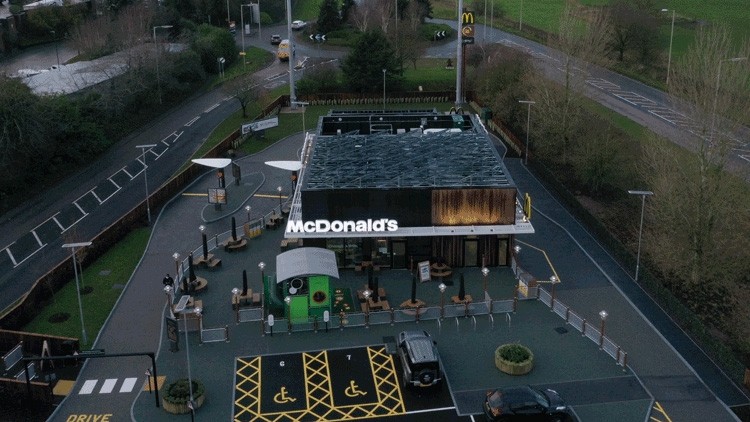
Others put forward earlier targets, with several businesses announcing they had reached carbon neutral status – a precursor to net zero that only requires scope one and two emissions to be targeted, with scope three encouraged but not mandatory. Carluccio’s and Slim Chickens operator Boparan Restaurant Group (BRG) says that all of its nationwide brands are now certified as carbon neutral thanks to a combination of switching to green energy across its estate and offsetting all of its scope one emissions, and cocktail bar and restaurant group The Alchemist says it is now a carbon neutral business after offsetting its scope one and two emissions.
Last year, the Sustainable Restaurant Association (SRA) launched a Net Zero Restaurants Initiative (see boxout below) in partnership with Net Zero Now. The initiative allows operators to calculate their carbon emissions, set targets, get tailored reduction plans and compensate for pre-existing emissions. Businesses can also be certified net zero or have their net zero target date certified.
“The hospitality sector, in particular, has some challenges around complexity,” says Heppner. “At Net Zero Now we do climate strategy across multiple sectors, and foodservice is one of the most formidable because of its supply chain. Those emissions related to the production of food and the variety and complexity of that supply chain is really complicated. That’s where businesses have previously found it too much and have been waiting for a solution to allow them to dive in.”
Juliane Caillouette-Noble, managing director of the SRA, says similar. “What we’re seeing, particularly from the bigger groups, is a lot of responsibility being taken for scope one and two emissions, with scope three being pushed down the line because the complexity of supply chains is hard to unpick. The problem is, in foodservice, scope three could count towards between 70% and 90% of a business’s emissions.”
How the SRA and Net Zero Now are helping restaurants develop a climate strategy
The figures speak for themselves. A pilot of the Net Zero Restaurants Initiative, created in partnership by the Sustainable Restaurant Association (SRA) and Net Zero Now and conducted last year, estimated that the cost to compensate for greenhouse gas emissions could be as low as 7.5p per cover. With groups including Hawksmoor and Wahaca taking part, the pilot found that most emissions were in the food itself (on average 77%), rather than operations (18.5%) or drinks (4.5%). If a restaurant replaced 10% of its meat use with plant-based options, it could potentially save 350 tonnes of carbon per year, equivalent to the greenhouse gas emissions emitted by 76 cars being driven for a year.
Meanwhile, if a restaurant switched to 100% renewable energy tariffs, they could save nearly 600 tonnes of carbon per year, equivalent to the greenhouse gas emissions of 67,000 gallons of petrol; and replacing one quarter of dairy usage with plant-based options could save over 300 tonnes of carbon per year.
“Developing a coherent and workable climate strategy involves calculating your footprint in accordance with some sort of global standard, setting some reduction targets that are in line with what we need to do to avoid dangerous warming, and then taking action to achieve those targets,” explains Simon Heppner, executive director of Net Zero Now. “The final part is having a comms plan to say ‘this is what we’re doing around the climate’ - that’s both important for your credibility, but also for that advocacy piece and demonstrating to the rest of the sector that this is what progressive businesses are doing.”
Juliane Caillouette-Noble, managing director of the SRA, notes that with businesses being squeezed by soaring energy and supply costs, building an understanding around sustainability and climate is essential. “I find it heartening that the sector isn’t just trying to keep its eyes closed,” she says. “Covid was a shock to the system, but it’s pushed the sector to realise we cannot now walk blindly into a climate disaster. We need to start laying down the groundwork to deal with it now. And a lot of these external pressures are an increasing incentive to do that now and not push it down the line.”
To find out more about the Net Zero Restaurants Initiative, click here.
Getting on the front foot
An early participant of the Net Zero Restaurants Initiative is steakhouse group Hawksmoor, which was one of several operators to take part in a pilot of the scheme. Led by the group’s head of sustainability Ellie Besley-Gould, Hawksmoor successfully achieved its target to become a carbon neutral company in February this year, some 11 months ahead of schedule, and is now setting its sights on becoming net zero by 2030.
Working with the SRA and Net Zero Now, Hawksmoor has not only managed to offset all its carbon emissions, but has started implementing practices to reduce its overall greenhouse gas emissions.
“We took all scope one, two and three emissions at the same time and then looked at a mix of offsets,” explains Besley-Gould. “They included simple things like planting and protecting trees, which locks in carbon that could otherwise be emitted, but we also wanted to have more complex and extensive projects so that we could do things that prevent and lock in carbon longer term.”
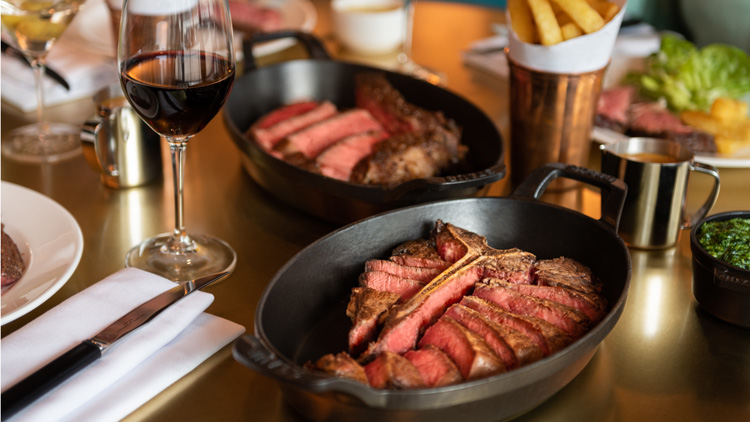
They include a clean cookstove campaign in Myanmar, which is working to reduce deforestation and improve energy access through the supply of fuel-efficient stoves; and a clean lamps initiative in Kenya making clean and renewable energy and lighting readily available to households.
While a greater understanding of the need to have a more robust response to climate change is discernible across the hospitality sector, it’s meat-focused restaurants like Hawksmoor and Gaucho that are at the forefront of its charge to reach net zero. Others to have set targets include Beefeater and Bar + Block operator Whitbread, which has pledged to reach net zero by 2040, and London-based chop specialist Blacklock, which aims to achieve B Corp status (see boxout below) within the next year and net zero by 2030 at the latest.
“A lot of the meat-focused businesses are not shying away from the fact that if there was some sort of carbon taxing, and if you’re paying for offsetting and mitigations, it’s going to be expensive,” notes Caillouette-Noble.
“What’s interesting is to see them go on the front foot to get a hold of what that looks like earlier than maybe they have to. If this becomes mandatory, it’s going to be better as a steak business to have already started driving your emissions down than be caught out with a bigger footprint in the future.”
Chasing B Corp status
While many businesses implementing a climate strategy have chosen to focus on attaining carbon neutral and, eventually, net zero status, others are pursuing a different accreditation – B Corp. While net zero hones in on reducing carbon emissions, B Corp Certification is a designation that a business is meeting high standards of verified performance, accountability, and transparency on factors from employee benefits and charitable giving to supply chain practices and input materials.
“B Corp was something that came up on my radar during the first Covid lockdown, and it felt like a natural step for us,” says Gordon Ker, founder of London-based chop specialist Blacklock, which announced its intentions to achieve B Corp status last year. “It spoke to us not as something we should be doing, but something we are doing and that we want to be a bigger part of.”
Ker describes Blacklock, which has sites in Shoreditch, Covent Garden and the City, as being ‘sustainably minded’, adding that from an operational standpoint the move to B Corp isn’t expected to be too challenging. The group promotes sustainability through its ‘Planet Promise’ that sees a tree planted for every customer that dines with them; and puts significant emphasis on creating a positive workplace culture that value its employees.
“We’re working with a consultant and completing our impact assessment at the moment, and the feedback is we’re doing all the right things. The biggest thing for us is formalising a lot of the policy around the practises we have.”
Right now, Ker’s focus is on ensuring that overlay of system and procedure is embedded in official company policy. “Once you become B Corp you’re continually reassessed as B Corp and they want to see you improving. So, a lot of our focus right now is on formalising those practises into our constitution.”
The benefit of attaining B Corp status, he adds, will be reflected both in the group’s customers and its staff. “As people we associate ourselves with brands that we admire and have purpose beyond just the point of sale. That’s true of restaurants too. You can go restaurants that also stand for things you value and we’re conscious of that.
“Our more guiding principle, though, is going back to our staff and giving them purpose. And we think that being a B Corp will help us in giving even further resolution to our people in coming to work every day.”
Challenges in the supply chain
One of the greatest challenges facing meat-focused restaurants looking to implement a climate strategy is their core product, which is widely regarded to be a significant contributor of carbon emissions.
“What gets column inches in newspapers is how meat is bad for the environment,” says Blacklock founder Gordon Ker. “That’s true in some respects, depending on where you source that meat from and if it comes from intensive farming practises. That’s obviously bad for the environment and bad for the animals; but then you go to the other end of the spectrum, like us, where the meat is all reared using regenerative farming practises and is climate positive.
“It all depends on what meat you’re buying and where you’re buying it from. We certainly say that you should be eating better meat less often.”
Regenerative farming is one those sustainability-related buzzwords that has seen growing prominence in the food industry in recent years, in part down to the work of environmentally conscious meat brand The Ethical Butcher and its annual Regenuary campaign. In essence, it describes a conservation and rehabilitation approach to food and farming systems that gives back to the environment more than it takes out.
“It’s important to understand that regenerative farming doesn’t refer to a prescriptive set of practices, but an outcome that’s based purely on results,” stresses Glen Burrows, co-founder of The Ethical Butcher.
Primarily, he says, the focus is on improvement in soil carbon measurement, and improvement in biodiversity. “The reason that these two metrics are so important is because our soils are hugely degraded. For decades, most arable crops have been taking and taking out of the earth and we haven't been putting back. When we have, we’ve been using chemicals instead of natural processes.
“When soil loses its carbon matter, that carbon usually ends up in the atmosphere in the form of carbon dioxide, so now what we're doing is using natural processes to rebuild root structure, soil carbon, and with that improve biodiversity, which starts in the soil and below ground. That then has a cascade effect up through different trophic levels of the ecosystem going above ground. And with all that increase in biodiversity, we're taking carbon out of the atmosphere, and putting it into the bodies of plants and animals.”
“There are many really cool farming projects at the moment where they’re locking in and sequestering carbon into the soil”
With a concentration on targeting their scope three emissions, both Hawksmoor and Rare Restaurants have begun working more closely with the farmers to ensure they are implementing science-based processes and measures to minimise their carbon output.
Hawksmoor is supplied by 600 farms and each of them will go through a carbon footprint process every two years, according to Besley-Gould. “Some use regenerative methods, but that’s such a broad term. There are many really cool farming projects at the moment where they’re locking in and sequestering carbon into the soil.
“Our focus is on ensuring they all adhere to our own standard levels, with the cattle leading a stress-free life and fed a foraged diet of hay and grass. Meat is our biggest emitter, and it’s our biggest selling product. That’s why this is so important to us. We know people are reducing their meat consumption, and so when they eat at Hawksmoor, we want them to have that quality assurance.”
Broadening the menu
Hawksmoor has also just added its first vegan dish to the menu, a plant-based take on its ricotta dumplings. This follows results from the Net Zero Restaurants Initiative pilot that found that if a restaurant replaced 10% of its meat with plant-based options, it could potentially save 350 tonnes of carbon per year.
Rare Restaurants too has grown its vegan offering, with Gaucho putting on a dedicated plant-based menu for Veganuary this year that featured a range of new dishes created by head chef Steve Allen. Gaucho now has two permanent plant-based mains on the menu including a king mushroom salad, and plans are in the works to add more.
While reducing emissions is a net benefit of having more plant-based choices on the menu, for Williams it’s more about diversifying the brand. “We want to create an offering that’s attractive to a broader range of demographics. In 2019, 95% of our customer base ate steak; now it’s closer to 80%. We’ve captured market share as a result of adding more vegetarian and vegan options to our menus and seen really significant double-digit growth as the brand is more accessible and therefore attractive.”
An unenviable task
Earlier this month, Williams launched a sustainable supper club at Gaucho’s Charlotte Street restaurant promoting a ‘zero waste’ ethos and the use of sustainable and local ingredients. Dishes included a ‘zero waste’ sourdough with sobrassada butter; grilled ox heart fazoletti with artichoke puree; and a goat’s milk cheesecake with London honey.
The monthly supper club will also, he hopes, allow the business to engage with its guests more directly about its environmental ambitions. “We want to try and forge a net zero dining experience. The idea is to learn the best practises and then roll it out across the group.”
There’s no doubt that restaurants trying to push down their carbon emissions face an unenviable task. On the small end of the scale, Williams has found himself comparing the footprint of a bee’s wax candle against a standard paraffin wax one; at the other end, the group is having to factor in the emissions of each staff member in their journey to work.
Hawksmoor has also found itself calculating the carbon footprint of each of its staff members’ journeys. “It’s difficult, as there’s big variations between sites,” says Besley-Gould. “In London, everyone either uses public transport or cycles; in Manchester, it’s a mix of public transport and driving. In Edinburgh, nearly everyone drives in.”
To try and push down those emissions, Hawksmoor has launched cycling schemes and walking challenges at a number its restaurants. There’s also been a significant reduction in head office travel between restaurants, with air travel all but banned. “If it’s for a meeting, we now have a policy of asking ‘do you need to go?’”
Besley-Gould credits Hawksmoor founders Will Beckett and Huw Gott with driving the agenda. The whole group’s estate switched to green electricity in October last year, and the team is now exploring the possibility of transitioning to gas-free kitchens in the future. One initiative currently being worked on by the kitchen teams is cutting the number of hobs used on the cookline by half during the morning prep period, with certain stoves also turned off in the afternoon between services. Other ideas include consolidating the supply chain of the group’s regional restaurants to use more local suppliers; and introducing LED lighting across the whole restaurant estate.
All standards set will be rolled out to the entire Hawksmoor portfolio, including the group’s restaurant in New York.
A question of cost
Another major challenge for Hawksmoor has been tackling its food waste. Chips, in particular, are singled out as being a high wastage product owing to internal quality control measures. As a result, the executive chef team are currently working on repurposing those chips that don’t make the cut as hash browns, which can then be served as a bar snack.
Efforts to reduce customer food waste are also being worked on. Front of house staff are trained on how to better advise guests on how much to order and doggy bags are normalised for those who do over order. Restaurants also provide recipe cards to show people what they can do with any leftovers.
More broadly, the challenges facing restaurants trying to reach net zero are matters of time, cost, and data collection. “Gathering the data is a perpetual issue,” says Caillouette-Noble. “Hospitality is made up of a lot of small and medium-sized businesses and for them to procure all the supply chain data they need just to work out their carbon footprint can be challenging.”
The cost to businesses implementing climate policies has weighed heavily on the mind of Williams. “What I realised very quickly was to do this was going to be really expensive,” he says. “Just doing the procurement study costs tens of thousands of pounds. If you put it all together, it’s a six-figure investment. Smaller businesses and start-ups can’t afford that.
“You might have the best intention and best ambition in the world to be carbon neutral or net zero and know it’s the right thing, but money is an obstacle here.”
In a bid to help those smaller companies, Williams launched the Sustainable Steak Movement to share best practise specifically with regards to developing a carbon neutral beef offer. The movement, which is open to all meat-focused restaurants, encourages operators to sign up to a manifesto and pledge that in 2022 they will offer a carbon-neutral beef option on their menus, as well as promote a ‘carbon neutral’ wine offering, commit to minimise food waste and the use of green energy in their restaurants.
“You might have the best intention and best ambition in the world to be carbon neutral or net zero and know it’s the right thing, but money is an obstacle here”
As well as smaller brands, Williams notes that bigger operators including Côte and the Brasserie Blanc group have expressed interest in the initiative. “Different companies are at different stages. But I’ve actually been pleasantly surprised by the fact that pretty much everyone we’ve approached has been supportive and wanted to be a part of this.”
The matter of offsetting
Heppner is clear to point out that restaurants can never reduce their food-related emissions to zero, and as such all hospitality businesses looking to reach net zero will have to consider offsets as part of their long-term climate strategy.
“Offsetting is very much the end of the line,” he says. “The foundation is calculating, setting targets, reducing emissions and communicating it. If you then want to look at your environmental impact and say ‘we’re going through these processes but recognise we’re still having a climate impact’, that’s where offsets comes in.”
Much has been said about the cons of offsetting. In an article published by the World Economic Forum last year entitled ‘Why carbon offsetting doesn't cut it’, Jennifer Morgan, executive director of Greenpeace International, wrote: “Net-zero pledges that use offsets simply cannot replace needed emissions reductions and fossil fuel phase-outs.”
Caillouette-Noble notes that the matter of offsetting is a tricky one for operators. “Businesses recognise the consumer hesitancy around offsets,” she says. “And in their messaging, they’re having to make it clear that they’re not trying to say ‘we will pay our way out of this problem’, but that using them is part of a larger strategy around carbon reduction.
“What’s interesting is by putting that compensation carbon cost into their accounting, it gives businesses an internal financial incentive to drive down their emissions.”
Besley-Gould agrees. “There are many flaws in the system, but what offsets help with is it puts a financial value on emissions, which you’re then inclined to reduce as you want to cut that cost. That in turn gives you a really good awareness of where your bigger emission profiles are.”
As well as offsetting, Caillouette-Noble adds that a number of foodservice businesses are exploring insetting, which refers to a company offsetting its emissions through a carbon offset project within its own value chain.
“From talking to some regenerative farmers there’s some interesting tools and ways you can do that now in terms of putting that capital into regeneration projects in your own supply chain,” she explains. “So, on the one hand, yes – you’re paying that cost for the carbon you’re emitting; and on the other end you’re making it lower emitting in the future.
“Fundamentally as an industry we can’t be a zero carbon one because we take things out of the earth and serve them and eat them. There isn’t a way to do that without a carbon cost. But thinking holistically about how you drive down emissions and also constantly investing in being better to the future for the planet is an interesting place to be.”
Reaching net zero
While Hawksmoor has set a 2030 target to be net zero, Besley-Gould is aiming to get there much quicker. “I think we can hit it in two years,” she says, confidently. “But the thing with net zero is once you hit it, the goalposts shift. It’s going to be a permanently ongoing battle.”
Neither Hawksmoor nor Rare Restaurants report there being much external pressure to implement climate strategies at the moment, although they both expect that to change in time. “We’re going to see a mass normalisation of companies doing more to reduce their emissions, and with that the customer expectation will change,” says Besley-Gould. “It will become one of those things that help dictate customers decisions.”
“We’re going to see a mass normalisation of companies doing more to reduce their emissions, and with that the customer expectation will change”
Williams has his own thoughts. “For us, there’s a commercial understanding that guests will demand carbon-free beef, and that’s balanced with the sustainability values of our staff and the wider business. We have a younger workforce, and this matters to them.”
Rare Restaurants’ 2030 target to reach net zero is realistic in Williams’ eyes, although he hopes the group may be able to get there sooner. “It’s a full-time investment to get there. No one has done it, so there will be unseen hurdles. Ultimately, though, the sector will be in a better place, and more attractive to diners.”
